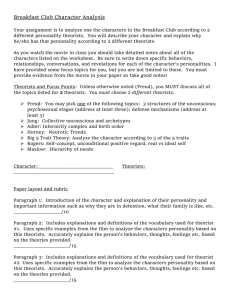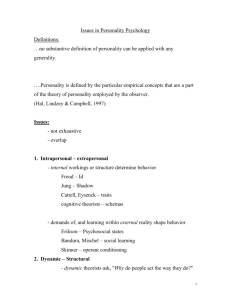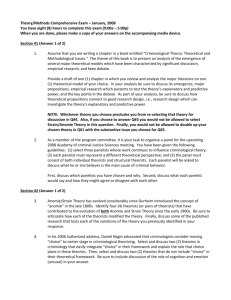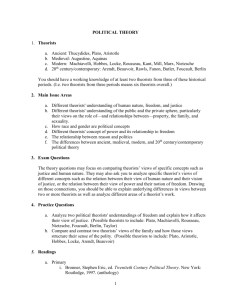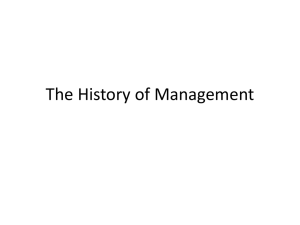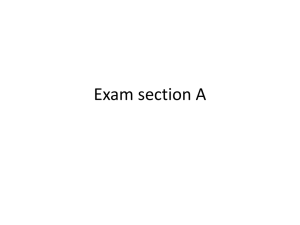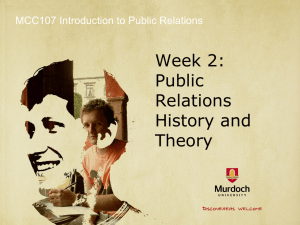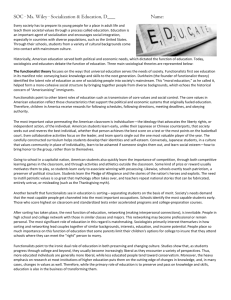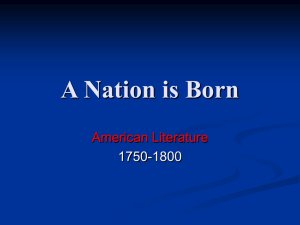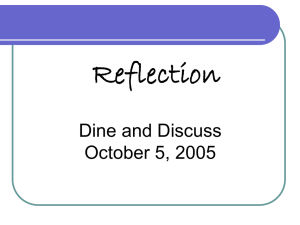Communication Theories Group Presentation Presentation
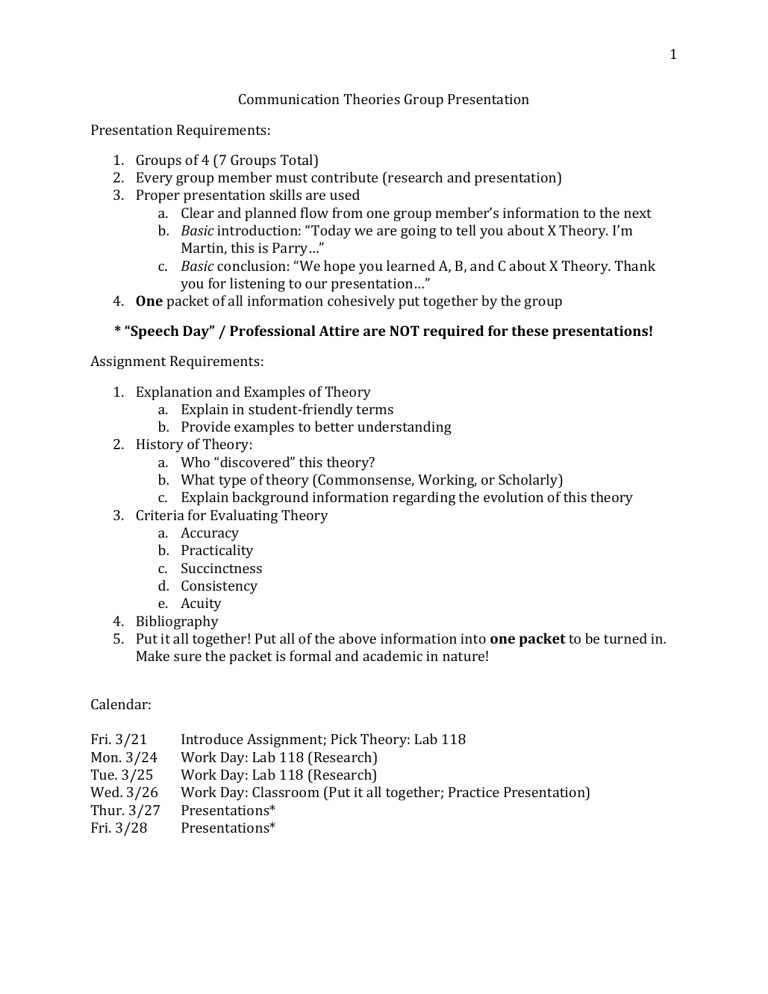
Communication Theories Group Presentation
Presentation Requirements:
1.
Groups of 4 (7 Groups Total)
2.
Every group member must contribute (research and presentation)
3.
Proper presentation skills are used a.
Clear and planned flow from one group member’s information to the next b.
Basic introduction: “Today we are going to tell you about X Theory. I’m
Martin, this is Parry…” c.
Basic conclusion: “We hope you learned A, B, and C about X Theory. Thank you for listening to our presentation…”
4.
One packet of all information cohesively put together by the group
1
* “Speech Day” / Professional Attire are NOT required for these presentations!
Assignment Requirements:
1.
Explanation and Examples of Theory a.
Explain in student-friendly terms b.
Provide examples to better understanding
2.
History of Theory: a.
Who “discovered” this theory? b.
What type of theory (Commonsense, Working, or Scholarly) c.
Explain background information regarding the evolution of this theory
3.
Criteria for Evaluating Theory a.
Accuracy b.
Practicality c.
Succinctness d.
Consistency e.
Acuity
4.
Bibliography
5.
Put it all together! Put all of the above information into one packet to be turned in.
Make sure the packet is formal and academic in nature!
Calendar:
Fri. 3/21 Introduce Assignment; Pick Theory: Lab 118
Mon. 3/24 Work Day: Lab 118 (Research)
Tue. 3/25 Work Day: Lab 118 (Research)
Wed. 3/26 Work Day: Classroom (Put it all together; Practice Presentation)
Thur. 3/27 Presentations*
Fri. 3/28 Presentations*
Cognitive Dissonance Theory
Cognitive Dissonance Theory argues that the experience of dissonance (or incompatible beliefs and actions) is aversive and people are highly motivated to avoid it. In their efforts to avoid feelings of dissonance, people will avoid hearing views that oppose their own, change their beliefs to match their actions, and seek reassurance after making a difficult decision.
2
Communication Accommodation Theory
This theoretical perspective examines the underlying motivations and consequences of what happens when two speakers shift their communication styles. Communication Accommodation theorists argue that during communication, people will try to accommodate or adjust their style of speaking to others. This is done in two ways: divergence and convergence. Groups with strong ethnic or racial pride often use divergence to highlight group identity. Convergence occurs when there is a strong need for social approval, frequently from powerless individuals.
Coordinated Management of Meaning
Theorists in Coordinated Management of Meaning believe that in conversation, people co-create meaning by attaining some coherence and coordination. Coherence occurs when stories are told, and coordination exists when stories are lived. CMM focuses on the relationship between an individual and his or her society. Through a hierarchical structure, individuals come to organize the meaning of literally hundreds of messages received throughout a day.
Cultivation Analysis
This theory argues that television (and other media) plays an extremely important role in how people view their world. According to Cultivation Analysis, in modern Culture most people get much of their information in a mediated fashion rather than through direct experience. Thus, mediated sources can shape people’s sense of reality. This is especially the case with regard to violence, according to the theory. Cultivation Analysis posits that heavy television viewing cultivates a sense of the world that is more violent and scarier than is actually warranted.
Cultural Approach to Organizations
The Cultural Approach contends that people are like animals who are suspended in webs that they created. Theorists in this tradition argue that an organization’s culture is composed of shared symbols, each of which has a unique meaning. Organizational stories, rituals, and rites of passage are examples of what constitutes the culture of an organization.
Cultural Studies
Theorists in cultural studies maintain that the media represents ideologies of the dominant class in a society. Because media are controlled by corporations, the information presented to the public is necessarily influenced and framed with profit in mind. Cultural Studies theorists, therefore, are concerned with media influenced and framed with profit in mind. Cultural Studies theorists, therefore, are concerned with media influence and how power plays a role in the interpretation of culture.
Dramatism
This theoretical position compares life to a drama. As in dramatic action, life requires an actor, a scene, an act, some means for the action to take place, and a purpose. A rhetorical critic can
understand a speaker’s motives by analyzing these elements. Further, Dramatism argues that purging guilt is the ultimate motive, and rhetors can be successful when they provide their audiences with a means for purging their guilt and a sense of identification with the rhetor.
3
Expectancy Violations Theory
Expectancy Violation Theory examines how nonverbal messages are structured. The theory advances that when communicative norms are violated, the violation may be perceived either favorably or unfavorably, depending on the perception that the receiver has of the violator.
Violating another’s expectations may be a strategy used over that of conforming to another’s expectations.
Face-Negotiation Theory
Face-Negotiation Theory is concerned with how people in individualistic and collectivistic cultures negotiate face in conflict situations. The theory is based on face management, which describes how people from different cultures manage conflict negotiation in order to maintain face. Self-face and other-face concerns explain the conflict negotiation between people from various cultures.
Groupthink
The groupthink phenomenon occurs when highly cohesive groups fail to consider alternatives that may effectively resolve group dilemmas. Groupthink theorists contend that group members frequently think similarly and are reluctant to share unpopular or dissimilar ideas with others.
When this occurs, groups prematurely make decisions, some of which can have lasting consequences.
Muted Group Theory
Muted Group Theory maintains that language serves men better than women (and perhaps
European Americans better than African Americans or other groups). This is the case because the variety of experiences of European American men are named clearly in language, whereas the experiences of other groups (such as women) are not. Due to this problem with language, women appear less articulate than men in public settings. As women have similar experiences, this situation should change.
The Narrative Paradigm
This theory argues that humans are storytelling animals. The Narrative Paradigm proposes a narrative logic to replace the traditional logic of argument. Narrative logic, or the logic of good reasons, suggests that people judge the credibility of speakers by whether their stories hang together clearly (coherence and whether their stories ring true (fidelity). The Narrative Paradigm allows for a democratic judgment of speakers because no one has to be trained in oratory and persuasion to make judgments based on coherence and fidelity.
Organizational Information Theory
This Theory argues that the main activity of organizations is the process of making sense of equivocal information. Organizational members accomplish this sense-making process through enactment, selection, and retention of information. Organizations are successful to the extent that they are able to reduce equivocality through these means.
4
Relational Dialectics Theory
Relational Dialectics suggests that relational life is always in process. People in relationships continually feel the pull-push of conflicting desires. Basically, people wish to have both autonomy and connection, openness and protective-ness, and novelty and predictability. As people communicate in relationships, they attempt to reconcile these conflicting desires, but they never eliminate their needs for both of the opposing pairs.
The Rhetoric
Rhetorical theory is based on the available means of persuasion. That is, a speaker who is interested in persuading his or her audience should consider three rhetorical proofs: logical, emotional, and ethical. Audiences are key to effective persuasion as well. Rhetorical syllogism, requiring audiences to supply missing pieces of a speech, are also used in persuasion.
Social Exchange Theory
This theoretical position argues that the major force in interpersonal relationships is the satisfaction of both people’s self-interest. Theorists in Social Exchange posit that self-interest is not necessarily a bad thing and that it can actually enhance relationships. The Social Exchange approach views interpersonal exchange posit that self-interest is not necessarily a bad thing and that it can actually enhance relationships. The Social Exchange approach views interpersonal exchanges as analogous to economic exchanges where people are satisfied when they receive a fair return on their expenditures.
Social Penetration Theory
This theory maintains that interpersonal relationships evolve in some gradual and predictable fashion. Penetration theorists believe that self-disclosure is the primary way that superficial relationships progress to intimate relationships. Although self-disclosure can lead to more intimate relationships, it can also leave one or more persons vulnerable.
Spiral of Silence Theory
Theorists associated with Spiral of Silence Theory argue that due to their enormous power, the mass media have a lasting effect on public opinion. The theory maintains that mass media work simultaneously with Majority public opinion to silence minority beliefs on cultural issues. A fear of isolation prompts those with minority views to examine the beliefs of others. Individuals who fear being socially isolated are prone to conform to what they perceive to be a majority view.
Standpoint Theory
This theory posits that people are situated in specific social standpoints-they occupy different places in the social hierarchy. Because of this, individuals view the social situation from particular vantage points. By necessity, each vantage point provides only a partial understanding of the social whole. Yet, those who occupy the lower rungs of the hierarchy tend to understand the social whole. Yet, those who occupy the lower rungs of the hierarchy tend to understand the social situation more fully than those at the top. Sometimes, Standpoint Theory is referred to as
Feminist Standpoint Theory because of its application to how women’s and men’s standpoint differ.
5
Structuration Theory
Theorists supporting the structurational perspective argue that groups and organizations create structures, which can be interpreted as an organization’s rules and resources. These structures, in turn, create social systems in an organization. Structuration theorists posit that groups and organizations achieve a life of their own because of the way their members utilize their structures. Power structures guide the decision making taking place in groups and organizations.
Symbolic Interaction Theory
This theory suggests that people are motivated to act based on the meanings they assign to people, things, and events. Further, meaning is created in the language that people use both with others and in private thought. Language allows people to develop a sense of self and to interact with others in community.
Uncertainly Reduction Theory
Uncertainty Reduction Theory suggests that when strangers meet, their primary focus is on reducing their levels of uncertainty in the situation. Their levels of uncertainty are located in both behavioral and cognitive realms. That is, they may be unsure of how to behave (or how the other person will behave), and they may also be unsure what they think of the other and what the other person thinks of them. Further, people’s uncertainty is both individual level and relational level.
People are highly motivated to use communication to reduce their uncertainty according to this theory.
Uses and Gratifications Theory
Uses and Gratifications theorists explain why people choose and use certain media forms. The theory emphasizes a limited effect position; that is, the media have a limithe effect on their audiences because audiences are able to exercise control over their media. Uses and
Gratifications Theory attempts to answer the following: What do people do with the media?
6
Group Grade: Research and Presentation
Needs Improvement
-
Meets Requirements
√- √ √+
Exceeds Expectations
+
Basic Introduction
Explanation and Examples of
Theory:
Explain in student-friendly terms
Provide examples to better understanding
History of Theory:
Who “discovered” this theory?
What type of theory (Commonsense,
Working, or Scholarly)
Explain background information
regarding the evolution of this theory.
Criteria for Evaluating Theory:
Accuracy
Practicality
Succinctness
Consistency
Acuity
Bibliography:
Creditable Sources
Applicable and Relevant
Correct MLA format (title, hanging
indent, etc.)
Packet:
Professional
Informative
Includes all information mentioned
when presenting
Basic Conclusion
Group Member
Group Member #1
Individual Grades: Information and Delivery
Information:
Accurate
Vocal Delivery:
Volume
Physical Delivery:
Eye Contact
Relevant
Informative
Rate
Pitch
Vocal Emphasis /
Inflection
Articulation and
Pronunciation
Posture
Gestures
Facial Expressions
Group Member #2
Group Member #3
Group Member #4
Deductions:
Time Requirement 3:45-4:30
Late or Missing Work
Unprofessional Attire
Excessive Filler Words
Distractions
7
______/50 Points Total
8
Name: ______________________________________________________ Theory: _________________________________
Peer Evaluation
Group Member #1: __________________________________________________________________________________
Overall Effort:
Use of Class Time:
(Low) 1
(Low) 1
2
2
3
3
4
4
5 (High)
5 (High)
Presentation:
Overall Grade:
(Low) 1
F
2
D
3
C
4
B
5 (High)
A
Explanation of Grade: _______________________________________________________________________________
_________________________________________________________________________________________________________
Group Member #2: __________________________________________________________________________________
Overall Effort:
Use of Class Time:
Presentation:
(Low) 1
(Low) 1
(Low) 1
2
2
2
3
3
3
4
4
4
5 (High)
5 (High)
5 (High)
Overall Grade: F D C B A
Explanation of Grade: _______________________________________________________________________________
_________________________________________________________________________________________________________
Group Member #3: __________________________________________________________________________________
Overall Effort: (Low) 1 2 3 4 5 (High)
Use of Class Time:
Presentation:
(Low) 1
(Low) 1
2
2
3
3
4
4
5 (High)
5 (High)
Overall Grade: F D C B A
Explanation of Grade: _______________________________________________________________________________
_________________________________________________________________________________________________________
